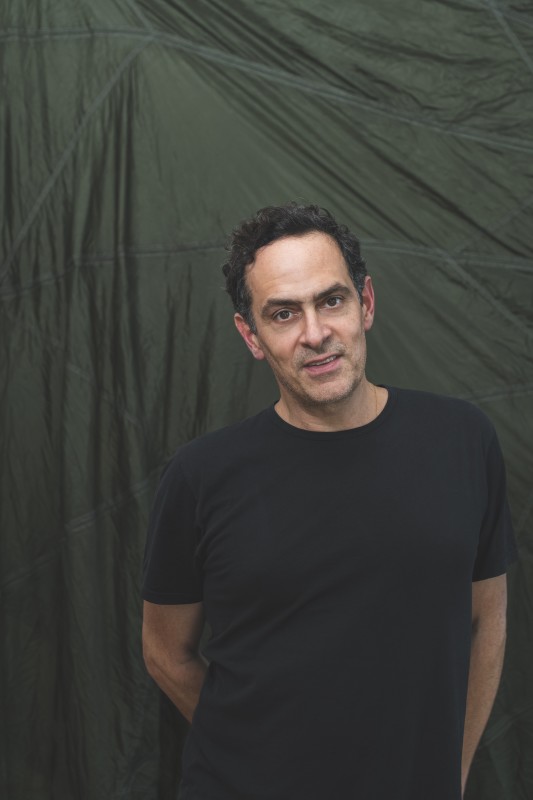Alexandre da Cunha (b.1969) is a Brazilian-born artist who lives and works in São Paulo and London. He has referred to his practice as ‘pointing’ as opposed to ‘making’. By ‘pointing’ at existing objects in plain sight, da Cunha highlights new and unexpected meanings within the objects he chooses. This approach allows him to disentangle preconceptions and instinctive responses inherent to particular objects, restoring them with alternative modes of viewing and understanding. Given their renewed possibility, da Cunha’s sculptures inspire lush potential, illuminating everyday encounters with these ordinary materials. For instance, household cleaning objects suddenly conjure spiritual significance, while seemingly mundane industrial ready-mades echo art historical precedents.
Central to da Cunha’s practice is the ready-made. Specifically, how the ready-made is affected by narrative, history, and the results of labour. In da Cunha’s work, an object’s original design and function endures within the sculpture: a mop can be transformed into a tapestry but the narrative of the object lives on in the work. In this way, da Cunha’s sculptures constitute a microcosm which preserves the historic and economic reality of the original object. In his Mix (2012-2017) and Full Catastrophe series (2012-2013), da Cunha presents concrete mixers only lightly touched by the artist but heavily manipulated by their previous owners, confusing the role of creator while aligning the activity of labour with that of the artist. In contrast, da Cunha’s Ikebana series (2018) assembles sensitive pairings of objects. A walking stick is accented by a fragment of food packaging; a hammer is domesticated by its foundation of a wooden block; while a cake tin, golf ball, or glass bottle sink into a cast of concrete.
Da Cunha’s employment of these materials places his work in dialogue with the modernist architecture common to São Paulo’s streets, where da Cunha grew up. More than just a material, concrete is infused with the ideals and aesthetics of modernism. Though predominantly functional and inexpensive, da Cunha points to its accidental romantic and even lyrical qualities.
Large-scale commissions and outdoor sculptures are integral to da Cunha’s practice, extending from his investigation of modest materials and vernacular visual formats. For his public commission in 2016 in São Paulo (Mix II), da Cunha presented the found drum of a concrete mixer truck placed on a giant plinth of cast concrete. Here, the materials and processes traditionally used in the construction industry are exalted to the status of artworks in their own right. In 2021, da Cunha’s permanent commission for Art on the Underground, titled Sunset, Sunrise, Sunset, was unveiled at the newly opened Battersea Power Station Underground Station. Drawing on the rotating advertising billboard, da Cunha’s kinetic sculpture runs along the ticket hall in the form of two monumental friezes composed of panels in various colours extracted from photographs of London sunsets and sunrises; throughout the course of the day, the panels rotate and change colours, creating an ever-changing environment within the station.
Selected solo exhibitions include: Quebrada, auroras, São Paulo, Brazil (2023); Duplex, Brighton CCA, Brighton, England (2021); Arena, Thomas Dane Gallery, Naples, Italy (2020); Duologue with Phillip King, Royal Society of Sculptors, London, England (2018); Boom, Pivô, São Paulo, Brazil (2017); Free Fall, Thomas Dane Gallery, London, England (2016); the Museum of Contemporary Art Chicago, Chicago IL (2015); Dublê, Centro Cultural São Paulo, São Paulo, Brazil (2011), and Laissez-Faire, Camden Arts Centre, London, England (2009). Da Cunha’s work is included in major private and institutional collections including the Tate, England; ICA Boston, USA; Museum of Contemporary Art Chicago, Chicago, USA; Pinacoteca do Estado de São Paulo, São Paulo, Brazil; and Inhotim, Brazil.
Major public and outdoor sculptures by da Cunha are on permanent view at Battersea Power Station Underground Station in London, the Monsoon Building in London, the Laumeier Sculpture Park in St. Louis USA, Pierce Boston Tower in Boston USA and the Rochaverá Tower in São Paulo, Brazil.

